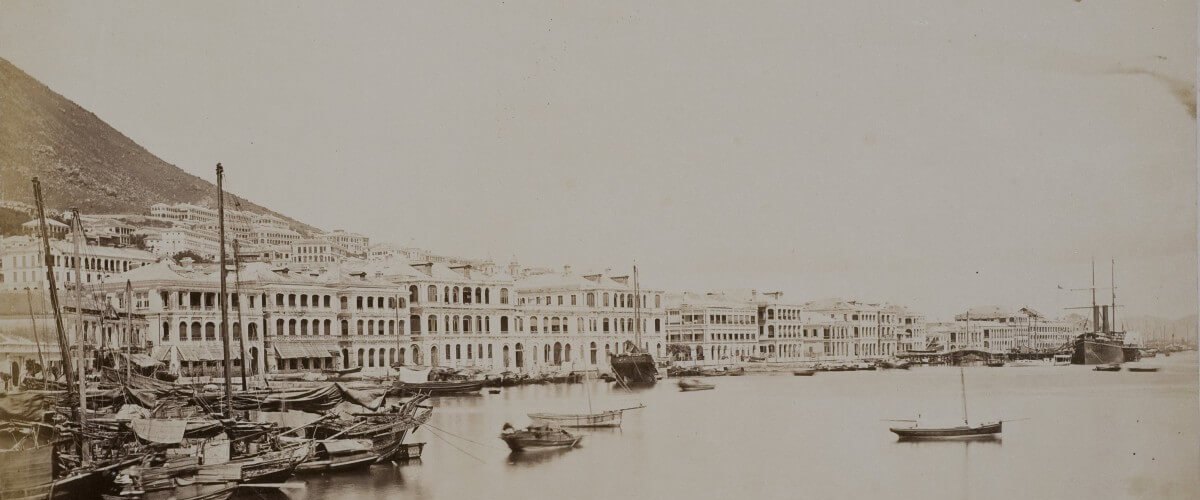William P. Floyd views of Hong Kong
This week’s blogpost is provided by Dr Angela Cheung (Research Fellow in photography at The National Archives). We are very grateful to her for not only initiating the work described in the post but also for taking the time to write and explain some of the team’s findings.
In late 2023, I, along with my colleague Dr Marc Vermeulen (Senior Conservation Scientist, The National Archives), visited The Royal Asiatic Society to study some of their early photographs of Hong Kong. Of particular interest was an album of 46 photographic views, the majority of which were of Hong Kong and Macao with a small number of Singapore, Canton, and Penang.
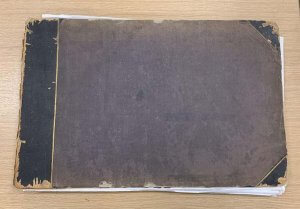
This half-leather bound album measures around 31 x 48.2 cm and although its provenance is uncertain, the majority of the photographs were made by a photographer called William Pryor Floyd (1834-c.1900), an Englishman who ran a photographic studio in Hong Kong from 1866-1874.[1] Advertisements from the time show that Floyd was selling views of Hong Kong and Macao by 1868, if not before. Most of Floyd’s photographs found in this album were made between 1866 and 1868. Photographs could either be bought as a complete mounted set in an album or as unmounted single prints. Six of Floyd’s photographs from The Royal Asiatic Society are also found in an early album within the former Colonial office library collection (CO1069) at The National Archives.
My research fellowship focuses on how photographs, commonly found in photographic albums or other forms of storage, are impacted materially by the ways they have been handled, stored and used within different types of collections. I am particularly interested in how material changes to the photographs can help us better understand the complex role that photography played in ideas about Britain’s rapid imperial expansion. This is where heritage science becomes a valuable addition to the art historical study of photographs and conservation strategies. Scientific analysis can not only identify how photographers and studios employed techniques and materials but it can also help build a picture of how photographs were used. Marc used an X-Ray Fluorescence Spectroscopy (XRF) machine which uses X-ray signals to help identify the elemental composition of a photograph.
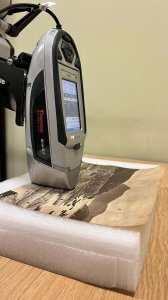
This process is non-invasive and allows for information to be gathered in a safe way from the photographs. We tested six Floyd photographs which are found in both collections and this allowed us to compare the chemistry, paper composition and to further investigate the natural degradation happening within the photographs; all of which provided information about how the photographs were made and how they’d been cared for over time. [2]
One of the tests that we did was to work out why the colour of a photograph of the Hong Kong hotel at The Royal Asiatic Society was more yellow than the one at The National Archives. [3] Could this have been due to different storage conditions? Or due to different toning practices?
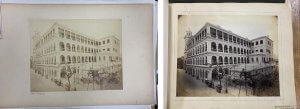
XRF analysis of the darkest areas on both prints showed that gold (Au) was used in the toning of both photographs, however gold (Au) and silver (Ag) were found to be present in much higher amounts in The National Archives photograph, which would explain why it is less yellow In the nineteenth century, gold toning was used to inhibit the problematic fading of albumen photographs; however it was a relatively expensive process. Another finding was the presence of barium (Ba) in The Royal Asiatic Society photograph which suggests the use of barium sulphate, or baryta, as a layer coating. Barium was not found in such pronounced amounts in The National Archives copy and this shows that different paper stock was used for the printing of each set of photographs, a finding that was not possible to ascertain from a visual analysis alone, since they were both mounted onto album paper.
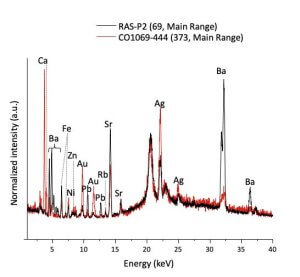
The use of different toning, and different paper stock, is evidence that the photographs were produced at different times by the same studio. [4] Since they are nearly identical in subject matter, although they differ in terms of cropped print size, it is evident that they were produced from the same negative. This is corroborated by the presence of this exact photograph in many other collections around the world. Our scientific analysis shows that the quality and materials of prints could vary greatly and shows that XRF analysis can play a vital role in revealing hidden and complex material history, invaluable to the art historical study of photographs. Since early photography in Hong Kong was a laborious and expensive process which required the use of imported chemicals and materials, it seems that Floyd studio was producing many copies of this photograph to meet what must have been a strong local demand and points to a thriving photographic market in Hong Kong early in its history.
[1] Floyd, the son of a tavern owner, had made his way to China by 1864, working in photographic studios in Shanghai and Macao as an studio assistant. By 1866 he had
established a photographic studio in Hong Kong.
[2] It should be noted that a degree of speculation is inevitable given that we don’t have consistent accounts of how these photographs were stored over the last 150 years.
[3] The Hong Kong hotel opened in 1868 and was finally demolished in 1952.
[4] Some studios, such as Lai Fong’s studio, bought or acquired negatives from photographers leaving Hong Kong which expanded their stock and sometimes making the attribution of photographs difficult, however the photographs from the RAS album appear to be from a set made available for sale in 1868.
Dr Angela Cheung was the National Archives Research Fellow in Photography from 2022-23 and her fellowship was funded by The National Archives Strategic Research Fund.
~ ~ ~ ~ ~
In other news we welcomed Professor Dame Jessica Rawson this week who lectured on ‘Gold, Horses and the Rise of the Silk Roads‘ looking at how the geography of the region had a particular impact on the development of the Silk Road. We also welcomed Robin Masefield who spoke on his recent publication, ‘The World Administered by Irishmen: The Life and Times of Robert Hart and Irish Contemporaries in East Asia’.
This coming week:
Tuesday 12th March, 6.30 pm, Ann Wilks (CBE) will discuss her new publication, Britain’s Man on the Spot in Iraq and Afghanistan, in which she examines newly discovered papers and colourfully-written letters of the Anglo-Irishman, Sir Henry Dobbs, and reveals his importance in the development of the modern Middle East.
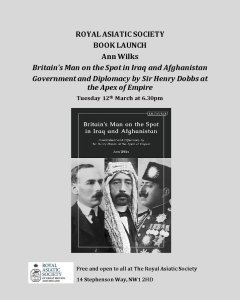
Thursday 14th March, 6.30 pm, Dr Juan de Lara will lecture on Qaryat al Fāw: An Emporium Between the Classical and Islamic World. Qaryat al Fāw, a pre-Islamic site in central Arabia served as a confluence of Arabic and Hellenistic cultures. In his lecture, Juan de Lara will discuss how the art discovered at Qaryat al-Faw served to establish a compelling connection between an urban settlement predating the emergence of Islam, and the art and culture of the first Islamic dynasty of the Umayyads, revealing a continuity in motifs, technique, and styles.
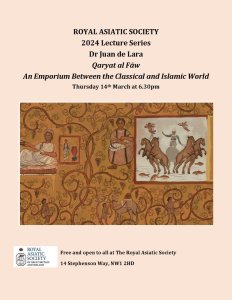
All are welcome to attend either event in person or via zoom. Please contact Matty Bradley (mb@royalasiaticsociety.org) to join online.

